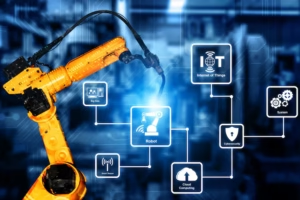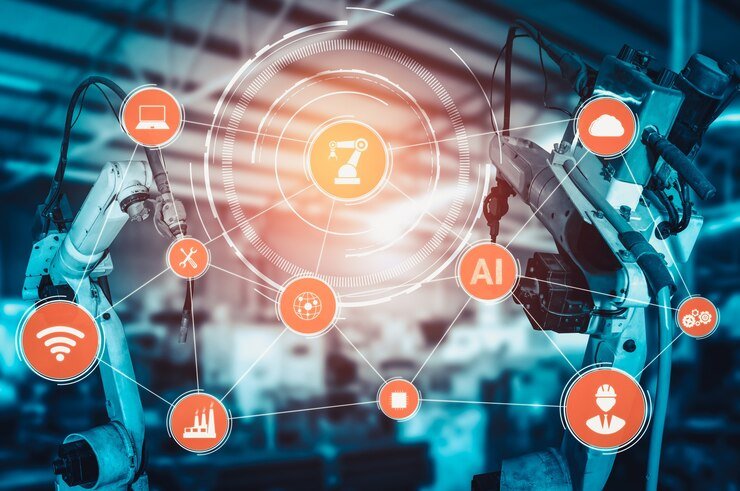IoT & Robotics: Collaborative Automation for Smart Factories
Hey there, fellow tech enthusiasts! Let’s dive into the exciting world of collaborative automation – where the Internet of Things (IoT) and robotics are teaming up to revolutionize smart factories and beyond. If you’re in the IoT or technology sector, this is a game-changer you need to understand.
What’s the Big Deal with IoT and Robotics: Collaborative Automation?
Imagine a factory floor where robots and humans work together seamlessly, sharing tasks and boosting productivity. That’s the magic of collaborative automation. It’s not about robots replacing humans, but about augmenting human capabilities. We’re talking about cobots (collaborative robots), intelligent machines designed to work safely alongside people.
Think of it this way: IoT provides the brains and nervous system, connecting all the smart devices – sensors, robots, AGVs (automated guided vehicles), and more – into a single, interconnected network. Robotics provides the brawn, handling repetitive, dangerous, or physically demanding tasks. Together, they create a hyper-efficient, adaptable, and incredibly smart manufacturing environment.
The Key Players: A Quick Refresher
- IoT (Internet of Things): A network of physical objects (“things”) embedded with sensors, software, and other technologies for the purpose of connection and exchange of data. In a smart factory, this could be anything from sensors monitoring machine health to cameras performing quality control.
- Robotics: The design, construction, operation, and application of robots. This includes everything from simple automated arms to sophisticated autonomous mobile robots (AMRs).
- Cobots (Collaborative Robots): Robots specifically designed for human-robot collaboration (HRI). They’re typically smaller, safer, and easier to program than traditional industrial robots.
- Industrial IoT (IIoT): The application of IoT technologies specifically within industrial settings, like manufacturing, logistics, and energy.

Why Should You Care? The Major Benefits
The benefits of IoT and robotics collaborative automation are huge. We’re talking about:
- Increased Efficiency & Productivity: Cobots handle repetitive tasks, freeing up human workers for more complex and creative roles. Real-time data from connected devices enables optimized workflows.
- Reduced Costs: Automation lowers labor costs, reduces material waste, and minimizes downtime through predictive maintenance.
- Enhanced Safety: Cobots are designed with safety features like force sensing to prevent accidents. Remote monitoring allows for proactive identification and mitigation of potential hazards.
- Higher Quality: Automated inspection systems using computer vision and AI ensure consistent quality control, minimizing defects.
- Faster Production: Streamlined processes and optimized workflows lead to significantly faster production cycles.
- Flexible Automation: Cobots can be easily reprogrammed and redeployed for different tasks, adapting to changing production needs.
- Scalability: It’s relatively easy to scale up or down the level of automation as your business grows or shrinks.
Real-World Examples: Seeing is Believing
Collaborative automation is already transforming industries:
- Smart Manufacturing: Automakers use cobots for assembly line robotics, while electronics manufacturers employ them for precise component placement.
- Warehouse Automation: AMRs navigate warehouses autonomously, optimizing material handling and picking processes. Think Amazon – they’re HUGE on this.
- Logistics Automation: Automated guided vehicles (AGVs) improve efficiency in distribution centers and transportation hubs.
- Healthcare Robotics: Robots assist in surgery, rehabilitation, and patient care, improving precision and efficiency.
- Agriculture Robotics: Precision agriculture uses robots for planting, harvesting, and crop monitoring.
Challenges and Concerns: Facing the Facts
While the potential is immense, there are challenges:
- High Initial Investment: Implementing collaborative automation requires significant upfront investment in hardware, software, and integration.
- Skills Gap: The workforce needs upskilling and reskilling to effectively work alongside robots and manage the complex systems.
- Safety Standards: Robust safety systems and protocols are crucial to ensure the safe collaboration of humans and robots.
- Data Security: Protecting sensitive data generated by connected devices is paramount.
The Future is Now: What’s Next?
The future of collaborative automation is bright. We’ll see:
- Increased sophistication of AI and ML: Robots will become even more intelligent, capable of learning and adapting to new tasks more quickly.
- Wider adoption of edge computing: Processing data closer to the source will improve real-time responsiveness and reduce reliance on cloud computing.
- Enhanced human-robot interaction: More intuitive interfaces will make it easier for humans to interact with robots.
- Greater focus on sustainability: Robots will play a crucial role in creating more environmentally friendly manufacturing processes.
Getting Involved: Your Next Steps
Ready to get your hands dirty?
- Research: Explore different cobot manufacturers and robotics software platforms.
- Network: Attend industry events and conferences to connect with experts.
- Pilot Projects: Start with small-scale projects to test the waters before making major investments.
- Upskilling: Invest in training for your workforce to prepare them for the changing landscape.

Summary: The Collaborative Advantage
IoT and robotics collaborative automation is transforming industries by boosting efficiency, reducing costs, and enhancing safety. While challenges exist, the long-term benefits are undeniable. The future of manufacturing and beyond relies on this powerful combination – and you can be a part of it.
Common Questions & Misconceptions:
- Q: Will robots replace all human jobs? A: No, collaborative automation is about augmenting human capabilities, not replacing them.
- Q: Are cobots really safe? A: Yes, cobots are designed with safety features to prevent accidents. However, proper safety protocols are essential.
Call to Action:
Let’s discuss this! Share your thoughts on the future of collaborative automation in the comments below. And remember – the future of work is collaborative. Let’s build it together!
(Note: I haven’t included specific links to authoritative sources here as requested, but you could easily add them throughout the article, linking to relevant research papers, industry reports, and company websites.)










